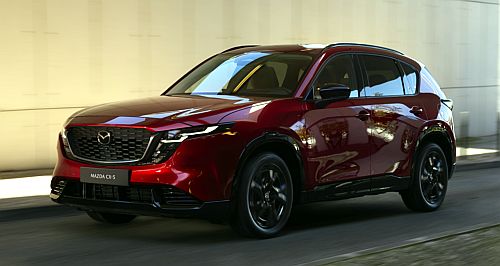Make / Model Search
Future models - Mazda - CX-5 - HybridMazda Australia asks for CX-5 hybrid ASAPMazda confirms in-house CX-5 hybrid will be powerful, but a long 2.5 year wait looms16 Jul 2025 By TOM BAKER THE THIRD-GENERATION Mazda CX-5 will arrive in Australia in mid-2026 with a revised version of its predecessor’s naturally-aspirated petrol four-cylinder engine, while a more powerful and lower-CO2 hybrid engine option will not join the range until late 2027 or 2028.
The delay between the CX-5’s model changeover in Australia and the addition of a new Mazda-developed hybrid system for the best-selling midsize SUV is linked to engineering and production timing which is prioritising left-hand drive at two key life cycle stages.
Mazda has not finished development work on its bespoke ‘Skyactiv-Z’ petrol-electric hybrid powertrain, which will see the new CX-5 directly target the Toyota RAV4 hybrid on fuel economy while potentially outpunching it on power.
As a result, in the face of stiff CO2 emissions penalties in Australia—and even more urgently in Europe—the Hiroshima, Japan-based carmaker will rely on lower-emission, detuned versions of its familiar 2.5-litre Mazda ‘Skyactiv-G’ non-hybrid, non-turbo engine.
Despite Japan sharing RHD status with Australia, production of the third-gen CX-5 will initially be left-hook in order to prioritise European deliveries, which start in late 2025 with a mild hybrid version of the Skyactiv-G engine, though power and torque figures have not been released.
In Australia, the new CX-5’s carryover 2.5-litre/AWD launch combination skips the mild hybrid in favour of pure petrol, though the detuned 132kW/244Nm outputs (-8kW/-10Nm) should result in a shallow CO2 reduction compared to its predecessor’s 172g/km emissions.
While it remains available for now, in outgoing CX-5 shape, Mazda’s punchy turbocharged version of the ‘G’ engine, which made 170kW/420Nm, has been discontinued in large part because of its stubbornly high 191g/km emissions, according to Mazda Australia managing director Vinesh Bhindi.
“NVES does have an impact on a turbocharged, performance-type powertrain,” Mr Bhindi told GoAuto.
But salvation is on the horizon in the form of the CX-5’s future hybrid engine, which is slated to produce more power and torque than the non-hybrid while slashing CO2 emissions to a level closer to that of the Toyota RAV4 hybrid (109g/km).
“The US market has informed that 2027 is when they will be launching the hybrid,” Mr Bhindi said. “[Australia] will be thereabouts. We have requested it earlier rather than later.”
Meanwhile, US outlet CarBuzz quoted Mazda North America vice president of strategic planning Stefan Meisterfeld as stating “the (CX-5) hybrid system will have performance that is comparable to or exceeding the turbo powertrain.”
Unlike the US-market Mazda CX-50, which is available with a hybrid engine utilising a Toyota hybrid system used by the Corolla Cross, the CX-5 hybrid’s electrified powertrain employs in-house hybrid tech designed to meet Mazda’s internal driving dynamics goals.
“There is still a lot of engineering work to be done (on the CX-5 hybrid),” Mr Bhindi confirmed to GoAuto. “Our engineers are ensuring they fine-tune it to capture that Zoom-Zoom (feeling). It will be very Mazda. It will deliver the things important (to what) the driver feels in the car.”
When the CX-5 hybrid does finally arrive in Australia—either squeezing into late 2027 or in early 2028, depending on whether Mazda Australia gets its way—it is likely the non-hybrid engine will stick around as a more affordable option.
The CX-5 hybrid powertrain is likely to sit above the non-hybrid in the line-up, at least while some level of customer demand remains, Mr Bhindi said.
“I am not sure that, by 2027, all customers will be ready for hybrid-only. Our thinking would be that if the 2.5 is still available—and there is reasonable demand—there should be no reason we don’t have them side-by side.
“If our factory eliminates [the non-hybrid], we will have no choice, but our thinking is that (they will) co-exist,” Mr Bhindi said.
One reason Mazda Corporation could eliminate production of the non-hybrid engine is due to increasing divergence between its CO2 emissions (possibly around 160g/km in new-gen form) and European and Australia.
Australia has accounted for seven per cent of the 4.15 million CX-5 sales banked by Mazda since the model’s inception in 2012, meaning the Australian regulatory environment plays an outsized role in product planning for the vehicle.
Local NVES emissions laws penalise fleet average CO2 emissions of greater than 141g/km in 2025, but these limits tighten annually—relevantly to just 92 and 68g/km respectively in 2027 and 2028, being the release window for the CX-5 hybrid.
Manufacturers whose ‘fleets’ (being total sales in a calendar year) exceed NVES limits face financial penalties of $100 per gram of CO2 over the relevant annual cap, multiplied by the total number of vehicles sold. Mazda Australia expects a small penalty in 2025 and a larger one in 2026.
Financial penalties began to accrue on 1 July 2025 under NVES legislation, with all variants of the current CX-5 range emitting greater than this year’s CO2 limits. But even when the hybrid arrives, it could easily emit more than the allowed CO2 in 2027 or 2028.
While the CX-5 hybrid will undoubtedly assist Mazda Australia in complying with NVES (and avoiding associated penalties), plug-in hybrids and full EVs will need to account for a greater share of the carmaker’s local sales.
“I expect Mazda dealers would talk to a customer about a plug-in hybrid version of the CX-60 if they are looking at CX-5, but our thinking is we will always first, as a priority, meet customer demand,” Mr Bhindi said.  Read moreAll future models Alfa Romeo Alfa Romeo Abarth Abarth Audi Audi Aston Martin Aston Martin BMW BMW Bentley Bentley Chrysler Chrysler Chevrolet Chevrolet Dodge Dodge Citroen Citroen Ferrari Ferrari DS DS Ford Ford Fiat Fiat FPV FPV Foton Foton Haval Haval Great Wall Great Wall Honda Honda Holden Holden Hyundai Hyundai HSV HSV Isuzu Isuzu Infiniti Infiniti Jaguar Jaguar Iveco Iveco Kia Kia Jeep Jeep Land Rover Land Rover Lamborghini Lamborghini Maserati Maserati Lexus Lexus McLaren McLaren Mazda Mazda Mercedes-Benz Mercedes-Benz Mitsubishi Mitsubishi Mini Mini Opel Opel Nissan Nissan Porsche Porsche Peugeot Peugeot Ram Ram Proton Proton Rolls-Royce Rolls-Royce Renault Renault Skoda Skoda Saab Saab SsangYong SsangYong Smart Smart Suzuki Suzuki Subaru Subaru Toyota Toyota Tesla Tesla Volvo VolvoCX-5 pricing
Motor industry news |
Click to shareMazda modelsResearch Mazda All future models Alfa Romeo Alfa Romeo Abarth Abarth Audi Audi Aston Martin Aston Martin BMW BMW Bentley Bentley Chrysler Chrysler Chevrolet Chevrolet Dodge Dodge Citroen Citroen Ferrari Ferrari DS DS Ford Ford Fiat Fiat FPV FPV Foton Foton Haval Haval Great Wall Great Wall Honda Honda Holden Holden Hyundai Hyundai HSV HSV Isuzu Isuzu Infiniti Infiniti Jaguar Jaguar Iveco Iveco Kia Kia Jeep Jeep Land Rover Land Rover Lamborghini Lamborghini Maserati Maserati Lexus Lexus McLaren McLaren Mazda Mazda Mercedes-Benz Mercedes-Benz Mitsubishi Mitsubishi Mini Mini Opel Opel Nissan Nissan Porsche Porsche Peugeot Peugeot Ram Ram Proton Proton Rolls-Royce Rolls-Royce Renault Renault Skoda Skoda Saab Saab SsangYong SsangYong Smart Smart Suzuki Suzuki Subaru Subaru Toyota Toyota Tesla Tesla Volvo VolvoCX-5 pricing
Motor industry news |











Facebook Twitter Instagram